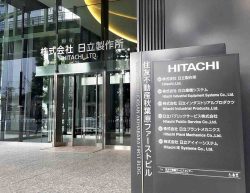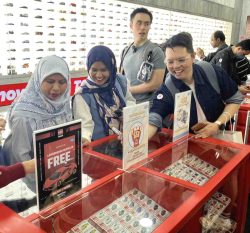12:27 JST, March 29, 2021
The novel coronavirus pandemic has buffeted railway companies, as more people work from home rather than commute to the office on trains. In an interview with The Yomiuri Shimbun, Tokyo Metro Co. President Akiyoshi Yamamura explained how the company that operates nine train lines and 180 stations mostly in Tokyo is coping with the challenges presented by the pandemic. Following are excerpts from the interview.
Our consolidated accounts for the period between April and December 2020 logged the first net loss since our company was privatized in 2004. Previously, our Tozai Line ran at 199% capacity at peak commuting times, making it Japan’s most crowded line. Now that figure is about 120%. The decline in passenger numbers has virtually eliminated all train delays, and we are reviewing where our security and other personnel are positioned within stations to better match the levels of congestion.
I believe that our society will change from a concentrated system of everyone going to work and coming home together all at once to a more disperse system. We are living in an age when people can increasingly choose where and when they work. We have seen changes in patterns of how passengers use our services, starting with more people working from home. I expect that even after the coronavirus situation is brought fully under control, our passenger numbers will hover around 80% to 90% of what they were before the pandemic. However, train schedules will still shape the rhythm of our society. That won’t change. Ensuring passengers can use our trains with peace of mind is our mission as a rail company. This is why we have undertaken far-reaching measures to prevent infections over the past year.
Opening two windows on Tokyo Metro line train cars by about 10 centimeters, combined with the air conditioning, enables all the air inside to be replaced by fresh air every eight minutes. We also partnered with a manufacturer to jointly develop a system that uses cameras and artificial intelligence to analyze congestion conditions inside our trains, and then promptly relay this information to commuters through a smartphone app. We launched a rewards program for users who avoid riding the Tozai and other lines during peak times.
We are also making more physically spacious areas at our stations. At our Nihombashi, Otemachi and Toranomon Hills stations, we are creating wide public spaces that connect with the surrounding area. Creating these spaces is crucial not only for combatting the virus, but also for efforts to respond when a disaster strikes. To meet the growing demand from people working remotely, we are building more private booths where people can work inside our subway stations.
If a large number of our train crew members were to become infected with the virus, our timetable would fall into disarray. Running a railway network is a 24-hour job that includes maintaining equipment. At times, our staff must stay together in our sleeping quarters. But to make sure we can respond if an emergency should occur, we have prepared work schedules for train crews on all our lines that allow them to quickly provide support. To drive a certain line, there are some things that only experienced crew members can understand, such as curves and inclines. We make sure that experienced conductors who formerly drove on the line within the past three years are available to quickly provide support if needed.
The declining profits of our shipping operations have necessitated a cut in our fixed costs. Digital technology holds the key to achieving this. For instance, until now, we replaced a train car’s motor or brakes after a certain number of years, even if these components were not damaged or malfunctioning. But now we have installed sensors that allow us to remotely detect any deterioration. We can intelligently conduct maintenance on parts that need it, and I’d like to make it easier to find breakages.
In Tokyo, communities have, for the most part, been built up around train stations.
If you think it’s difficult to visit distant areas now, I would urge you to explore the tourist spots in Tokyo, once the infections calm down. Beautiful nature, temples, shrines and venues where traditional arts are performed can be found near many subway stations in the capital.
We have released online videos in which actress Satomi Ishihara hops on a Tokyo Metro train and visits tourist spots in Tokyo. Revealing what hidden delights await near the station where one gets off is also a role for a railway operator. I am committed to making sure Tokyo Metro uses its extensive network to contribute to the capital, even after the coronavirus pandemic is behind us.
(This interview was conducted by Yomiuri Shimbun Staff Writer Tomoki Masuda.)

Akiyoshi Yamamura
Yamamura was born in Shizuoka Prefecture. Graduated from Tohoku University’s School of Engineering in 1980 and joined Teito Rapid Transit Authority (now Tokyo Metro Co.). He has been president since June 2017. He is 63.
"Business" POPULAR ARTICLE
-

Keidanren Chairman Yoshinobu Tsutsui Visits Kashiwazaki-Kariwa Nuclear Power Plant; Inspects New Emergency Safety System
-

Imports of Rare Earths from China Facing Delays, May Be Caused by Deterioration of Japan-China Relations
-

University of Tokyo Professor Discusses Japanese Economic Security in Interview Ahead of Forum
-

Japan Pulls out of Vietnam Nuclear Project, Complicating Hanoi’s Power Plans
-

Govt Aims to Expand NISA Program Lineup, Abolish Age Restriction
JN ACCESS RANKING
-

Keidanren Chairman Yoshinobu Tsutsui Visits Kashiwazaki-Kariwa Nuclear Power Plant; Inspects New Emergency Safety System
-

Imports of Rare Earths from China Facing Delays, May Be Caused by Deterioration of Japan-China Relations
-

University of Tokyo Professor Discusses Japanese Economic Security in Interview Ahead of Forum
-

Japan Pulls out of Vietnam Nuclear Project, Complicating Hanoi’s Power Plans
-

Govt Aims to Expand NISA Program Lineup, Abolish Age Restriction























